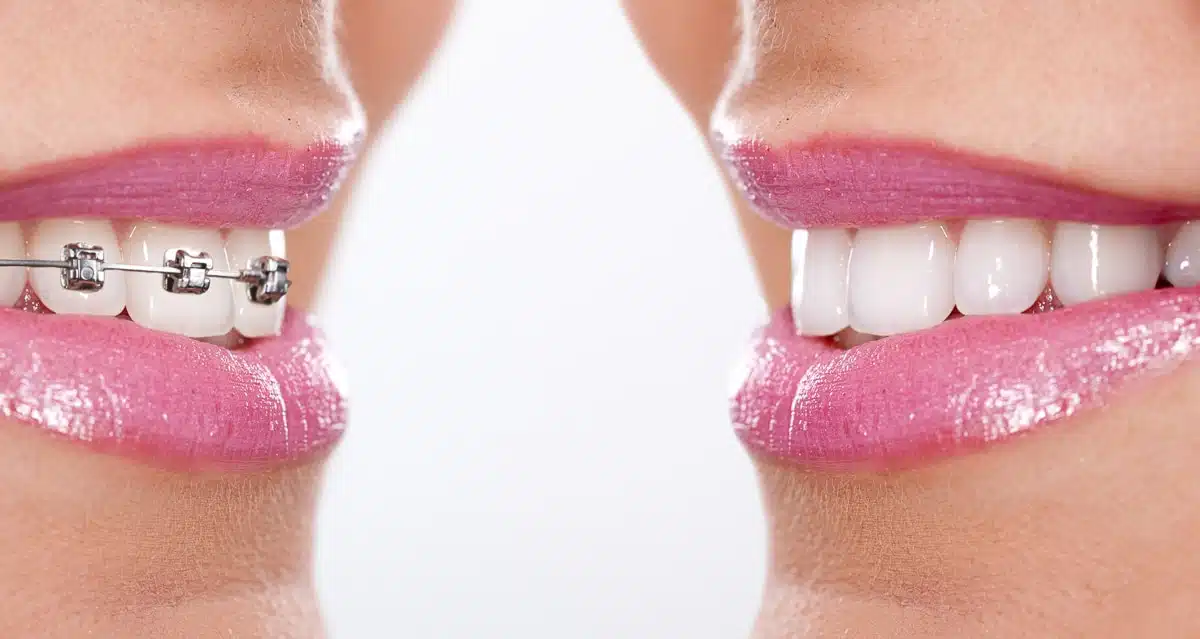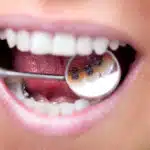Are you unsure whether fixed or loose braces are the right choice for you? Here we show you the advantages, disadvantages and costs.
Braces are a common solution to correct misaligned teeth and jaws.
There are two main types of braces: Fixed and loose braces. Both have their advantages and disadvantages, and the choice between them depends on various factors.
In this article, we’ll take a closer look at the differences, costs, and pros and cons of fixed and loose braces to help you make a decision.
| Get 150 € discount on your dental correction! |

Book a consultation appointment now at a nearby DrSmile partner practice and find out if teeth straightening with aligners is right for you.
The appointment is completely non-binding and does not involve any costs.
With the code “THATSMILE150” you will receive 150 € discount on the treatment.
What is a fixed brace?
Fixed braces, also known as multibracket appliances, consist of small metal or ceramic brackets that are bonded to the teeth.
These brackets are connected by a wire that pulls the teeth into the desired position.
Fixed braces are usually recommended for more extensive correction of misaligned teeth and jaws.
How fixed braces work
The fixed brackets are bonded to the teeth and the wire that runs through the brackets creates continuous forces to gradually move the teeth.
The dentist or orthodontist regularly adjusts the wire to monitor and adjust the progress of the treatment.
Advantages of fixed braces
- Effective correction of complex tooth and jaw malocclusions.
- Constant and controlled forces enable precise movements.
- The duration of treatment is usually shorter than with loose braces.
Disadvantages of fixed braces
- Visible metal or ceramic brackets can be perceived as disturbing.
- Difficulty in dental care and cleaning due to the solid structure.
- Dietary restrictions as certain foods should be avoided.

What is a loose brace?
Loose braces, also known as removable braces, consist of a plastic arch.
This is individually adjusted to exert gentle pressure on the teeth and move them into the correct position.
Unlike fixed braces, loose braces can be easily removed.
How loose braces work
The loose braces must be worn for a certain number of hours per day.
The plastic archwire applies gentle pressure to the teeth to gradually shift them and achieve the desired alignment.
Advantages of loose braces
- Easy removal for cleaning and during certain activities.
- No visible brackets, which can be more aesthetically pleasing.
- Fewer dietary restrictions because the brace can be removed.
Disadvantages of loose braces
- Possibly longer treatment time compared to fixed braces.
- Requires a high level of discipline, as it must be worn regularly.
- May cause speech difficulties in the first few days.
The alternative: Invisible braces (aligners)
Invisible braces consist of transparent, custom-made splints that are placed over the teeth.
They are almost invisible and can be easily removed for eating and brushing teeth.
Since providers such as DrSmile use advanced technology, the cost of the invisible braces is usually lower than that of traditional braces.
Fixed or loose braces: What are the costs?
The cost of braces treatment can vary depending on the type of braces. In general, fixed braces tend to be more expensive than loose braces.
Cost of fixed braces
The cost of fixed braces depends on several factors, such as the material of the brackets, the duration of treatment and the place of treatment.
As a rule, the cost of fixed braces ranges from 2,000 to 6,000 euros.
Cost of loose braces
Loose braces are usually less expensive than fixed braces. However, the cost varies depending on the individual fitting, material quality and the orthodontist.
A loose brace can cost between 500 and 2,500 euros.
When is what type of braces recommended?
The decision on which type of braces to recommend depends on the type of tooth or jaw misalignment.
Indications for fixed braces
- Severe malocclusions such as overbite, underbite or crossbite.
- Rotations or inclination of the teeth that require more extensive correction.
- Problems with the bite position, such as open bite or deep bite.
Indications for loose braces
- Mild to moderate misalignment of the teeth or jaw.
- Preventive measures to prevent misalignment of teeth and jaws.
- Aftercare after wearing fixed braces.
| Get 150 € discount on your dental correction! |

Book a consultation appointment now at a nearby DrSmile partner practice and find out if teeth straightening with aligners is right for you.
The appointment is completely non-binding and does not involve any costs.
With the code “THATSMILE150” you will receive 150 € discount on the treatment.
Duration of treatment with fixed and loose braces
The duration of treatment with braces can vary depending on the individual situation.
Treatment duration for fixed braces
Treatment with fixed braces usually lasts between 18 and 36 months.
The exact time frame depends on the severity of the misalignment, the patient’s cooperation and the individual reaction of the teeth to the treatment.
Treatment duration for loose braces
Treatment with loose braces can last between 6 and 24 months, depending on the type of misalignment and how long the braces are worn.
Care and hygiene with fixed and loose braces
Good dental hygiene is crucial during braces treatment, regardless of the type of braces.
Care for fixed braces
With fixed braces, thorough dental care is particularly important, as food debris can easily get caught in the brackets and wires.
Regular brushing, flossing and interdental brushing are necessary to prevent plaque formation and tooth decay.
Care for loose braces
With loose braces, it is important to clean the braces regularly to prevent bacterial growth.
The braces should be cleaned with a toothbrush and mild detergent or special cleaning tablets.

Which braces are the right choice?
The choice between fixed and loose braces depends on several factors, such as the severity of the misalignment, the patient’s individual needs and preferences, and budget.
It is important to carefully weigh the pros and cons of both options and seek individualized advice from a dentist or orthodontist to make the right decision.
Conclusion on the subject of fixed or loose braces
Deciding between fixed and loose braces is not an easy choice.
Both options have their advantages and disadvantages. Fixed braces provide effective correction for complex misalignments, but require more thorough dental care and may impose dietary restrictions.
Loose braces allow for easier cleaning and offer more freedom, but must be worn regularly and may take longer to treat.
It is important to seek a thorough consultation with a professional to consider individual needs and requirements.
| Get 150 € discount on your dental correction! |

Book a consultation appointment now at a nearby DrSmile partner practice and find out if teeth straightening with aligners is right for you.
The appointment is completely non-binding and does not involve any costs.
With the code “THATSMILE150” you will receive 150 € discount on the treatment.
FAQs on the subject of fixed or loose braces
At this point we will answer some frequently asked questions about the topic “fixed or loose braces”.
Does wearing fixed braces hurt?
During the first few days after fixed braces are fitted, you may experience slight pain and pressure, but this usually subsides.
Is braces treatment painful?
Minor discomfort may occur during braces treatment, especially after adjustments or wire changes. However, pain can be relieved with ice cubes or mild pain relievers.
Can I exercise while wearing braces?
Yes, you can exercise while wearing braces. However, it is advisable to wear a mouthguard during high-contact sports to protect your teeth and braces.
How often do I need to see the dentist or orthodontist during treatment?
Regular visits every 4 to 8 weeks are usually required so that the progress of the treatment can be checked and adjustments can be made. Most aligner providers, on the other hand, do not require face-to-face appointments.
What happens after the braces treatment is completed?
After completion of the braces treatment, a retention phase is usually initiated in which a retention appliance is worn to maintain the achieved results in the long term.



Leave a Reply